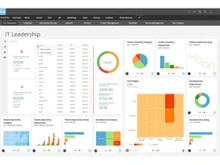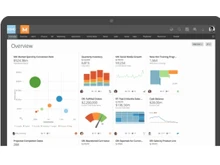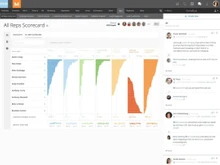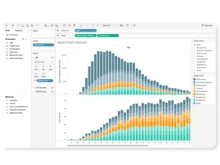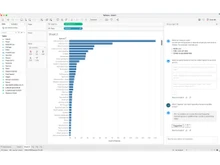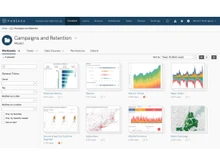Domo vs Tableau: Which Business Intelligence Software is Right For You?
The impact of selecting the appropriate business intelligence software can be significant in the way your company interprets and processes data.
Both Domo and Tableau are popular solutions that can assist businesses in transforming raw data into easy-to-read dashboards and insights easy to read. They have a similar objective but differ in data management, integrations, and convenience.
Domo is a cloud platform that enables direct connection to different data sources and offers real-time insights in a non-technical format. Tableau, by contrast, is more focused on deeper data visualization and analysis, and gives the user more control and flexibility to work in more detail with data.
This guide will address the key differences between Domo and Tableau, functionality, cost, ease of use, and the application areas that each tool is best suited to fit your business needs.
Key Differences Between Domo and Tableau
- User-Centricity and Ease of Use: Domo is friendly to any user, whereas Tableau requires expert data exploration.
- Platform Scope and Functionality: Domo is an end-to-end cloud platform with built-in ETL and collaboration, but Tableau is largely for visual storytelling and dashboards.
- Integration and Flexibility: Domo offers numerous prebuilt integrations, but Tableau offers flexible links and powerful R and Python integration.
Domo vs Tableau: Comparison Table
| Feature |
Domo |
Tableau |
| Deployment |
Fully cloud-native solution |
Cloud, desktop, and server options available |
| Data Processing |
Real-time data updates and automation |
Batch updates with manual refresh options |
| Collaboration |
Built-in team sharing and alerts |
Collaboration through Tableau Server or Cloud |
| Mobile Access |
Strong mobile app with full functionality |
The mobile app is mainly for dashboard viewing |
| Customization |
Prebuilt templates with limited deep customization |
Extensive dashboard customization and scripting |
| Learning Curve |
Easier for beginners and business users |
Steeper learning curve for non-technical users |
| Customer Support |
24/7 enterprise-grade support and community |
Standard support tiers and online resources |
| Security |
Cloud-managed with enterprise-level compliance |
Strong security with customizable access controls |
| Scalability |
Scales easily across departments and regions |
Scales well but needs added infrastructure setup |
| Best For |
Non-technical teams needing real-time insights |
Data professionals focusing on deep visual analytics |
| Pricing |
Price is available on request at Techjockey |
Price starting at USD 900 per year |
Detailed Feature Comparison of Domo and Tableau
Data Visualization and Dashboards
Tableau has a strong reputation due to its impressive visualization features, which enable users to build highly interactive and personalisable dashboards. It provides numerous charts, graphs, and mapping solutions. On the other hand, Domo also offers dashboards, but emphasizes simplicity and visual simplicity of use by non-technical users focused on clear, actionable insights over technical customization.
Data Preparation and ETL
Domo has in-built ETL (Extract, Transform, Load) capabilities, where users can clean, merge, and convert the information in the platform. This eases the task of business users handling data. On the other hand, Tableau needs distinct tools or Tableau Prep when preparing large amounts of complex data, which provides more versatility to technical users but needs extra time and skills.
Predictive Analytics and AI
Domo implements AutoML and AI-based applications, enabling non-technical users to create predictions and forecasts with ease. It automates sophisticated analytics applications. On the the hand, Tableau can run predictive analytics by connecting to R or Python, allowing analysts to flexibly implement advanced models, although Tableau does not support these without technical expertise.
Collaboration and Sharing
Domo also provides real-time team cooperation through team alerts, team notifications, and shared dashboards that can be found within the platform. This promotes accelerated decision-making among business units. In contrast, Tableau supports collaboration on Tableau Server or Tableau Cloud, where dashboards can be shared safely, but collaboration is more organized and might require IT expertise to install it.
Real-Time Data Monitoring
Domo is effective when it comes to the timely delivery of data and notifications that are useful in enabling companies to act swiftly on changing circumstances. Tableau, on the other hand, is largely engaged in deep analysis and visualization. Therefore, real-time monitoring can be performed, but it requires additional configuration or live data ties.
Advanced Analytics Flexibility
Tableau enables analysts to do complex calculations, write custom scripts, and use multidimensional data. It applies to detailed data exploration and scenario analysis. In contrast, Domo is more about out-of-the-box metrics and visualizations, and its analytics is easier for a business user, as compared to advanced custom modeling.
When to Choose Domo and Tableau?
| Scenario |
Choose Domo |
Choose Tableau |
| Quick Insights |
Best when business teams need fast, easy-to-understand dashboards |
Better when a deep analysis of large datasets is required |
| Executive Reporting |
Suitable for high-level summaries and KPI tracking |
Suited for detailed, customizable executive reports |
| Cross-Department Collaboration |
Works well for sharing insights across multiple teams instantly |
Collaboration is possible but more structured, and often needs an IT setup |
| Simple Forecasting |
Good for automated trend predictions and simple forecasts |
Best when advanced statistical modeling or scenario analysis is needed |
| Prebuilt Metrics |
Useful for ready-to-use business metrics and templates |
Better for creating unique, tailored calculations and reports |
| Speed to Insight |
Allows quick analysis and reporting with real-time data sharing |
Slower initial setup, focused on detailed exploration |
| Extensive Data Connectivity |
Over 1,000 pre-built connectors for seamless integration |
Integration is possible, but requires manual setup or coding |
Final Verdict: Domo or Tableau
The decision between Domo and Tableau relies on the needs of your team and their technical skills.
Domo is recommended to business users who prefer quick insights, easy dashboards, and real-time monitoring of their data without extensive technical knowledge. Tableau, on the other hand, is more appropriate for data analysts and technical teams interested in advanced visualizations, in-depth analytics, and very customizable dashboards.
Both solutions are good competitors in the business intelligence software market, yet you must select the one that fits your team's workflow, data sophistication, and reporting requirements. Get in touch with our software specialists or the Techjockey Team and get a free demonstration to get the right solution in relation to your business.


 5 Ratings & 0 Reviews
5 Ratings & 0 Reviews


